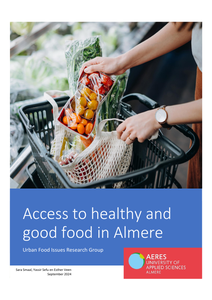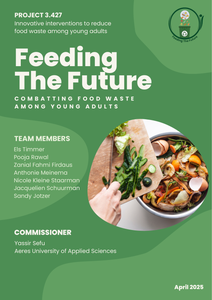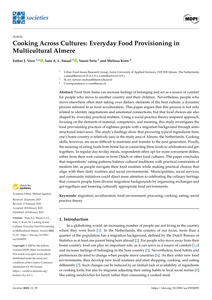Most beginning food forests face the following challenge: how do we get the harvest to the consumer? At food forest 't Mortelke they had the same question. The following research presents the answer to the following question: 'What are potential outlets for the harvest of Voedselbos 't Mortelke and how can these collaborations be realized?' The research provides more clarity on the needs of the market regarding potential collaborations with Voedselbos 't Mortelke. Interviews with interested parties (restaurants, country stores, organic supermarkets, individuals) revealed that the most appropriate form of cooperation with the food forest lies with fine-dining restaurants in the Eindhoven area. To initiate these collaborations an experimental phase is needed in which the chefs can get to know the products of the food forest. As a result of this research, several collaborations with restaurants have been initiated! Due to privacy reasons, certain parts of the research have been removed from the publication version.
DOCUMENT

Le chevalier delibere (1483) by Olivier de la Marche has an extensive hermit scene: the hermit receives the author, Acteur, gives him food and drink and instructs him in the important issues of life. Le chevalier delibere thus stands in two main Western European literary traditions: stories about hermits as such (who do or do not provide travellers with food and shelter) and stories in which food and drink have an allegorical function. This paper will discuss both traditions, without attempting to cover all hermit stories or all allegories about food and drink.
DOCUMENT

This report delves into food insecurity in Almere, focusing on how residents with limited financial means access and consume (healthy) food. The study employed an action research approach, engaging directly with affected individuals and stakeholders to understand their challenges and co-develop solutions. The primary aim was to empower participants by amplifying their voices and providing actionable insights into addressing food insecurity in the community. To achieve this aim we conducted workshops, in-depth interviews and a study using WhatsApp.
DOCUMENT

Currently, the Netherlands is still experiencing high levels of food waste, especially among young adults. Despite growing awareness on this topic, one specific group remains largely unexplored: Dutch vocational education (MBO) students. Therefore, this project explores the perceptions and current behaviour of this group regarding food waste and investigated the underlying determinants of food waste behaviour. Ultimately, the main purpose of this project is to provide insights and tailored interventions to reduce food waste behaviour among Dutch vocational education students. In this project, the Behaviour Change Wheel (COM-B model) serves as a theoretical foundation to understand and ultimately influence the food waste behaviour among students. To investigate the underlying food waste determinants and provide tailored interventions and recommendations, we conducted three main activities: literature review and desk research, the conduction of a quantitative survey, and qualitative interviews.Keywords: Food waste, COM-B, vocational students/MBO studenten, interventions.
DOCUMENT

Dit artikel gaat over de mogelijke introductie van micro-aardappelen, ofwel microtubers, op de Europese markt en de uitdagingen met betrekking tot alkaloïden. Aardappelen zijn wereldwijd essentieel voor voedselzekerheid, maar microtubers, kleine aardappelknollen, blijven relatief onbekend. Nederlandse producenten overwegen deze kleine knollen te gebruiken voor voedselproducten, maar de aanwezigheid van alkaloïden is een belangrijk aandachtspunt. Alkaloïden zijn natuurlijke stikstofhoudende verbindingen die in veel planten voorkomen, waaronder aardappelen (Solanum tuberosum L.). Sommige alkaloïden, zoals solanine en chaconine, kunnen schadelijk zijn bij inname in grote hoeveelheden, terwijl andere gunstige effecten kunnen hebben, zoals antioxidanten-eigenschappen. De regulering en etikettering van alkaloïden in voedsel variëren, wat de uitdagingen voor producenten benadrukt. Hoewel er interesse lijkt te zijn in microtubers in de Europese fine dining sector, zijn er momenteel weinig aanwijzingen voor een aanzienlijke markt voor consumptie van deze kleine aardappelen in Europa. In Oost-Aziatische landen worden microtubers voornamelijk gebruikt als pootgoed, wat de huidige beperkte kennis over het marktpotentieel in Europa benadrukt. Dit artikel benadrukt het belang van zorgvuldige teeltpraktijken en marktonderzoek voordat er grootschalige investeringen worden gedaan in de commerciële teelt van microtubers voor consumptie in Europa. De wetgeving met betrekking tot alkaloïden is momenteel nog niet concreet, en verder onderzoek is nodig om de gezondheidseffecten en mogelijke risico's beter te begrijpen. Samengevat, dit artikel biedt inzichten in de potentie van microtubers op de Europese markt, waarbij rekening wordt gehouden met de aanwezigheid van alkaloïden en hun impact op gezondheid en voeding. Het stimuleert producenten en onderzoekers om de mogelijkheden van microtubers verder te verkennen en te benutten.
DOCUMENT

In light of the current debate on the impact of our current food system on climate changeand related mitigation strategies, addressing the acceptance of sustainability aspects within consumerbehavioral issues is of vital importance. However, the field remains mute on how those strategies canbe designed and employed effectively to stimulate sustainable food consumption behavior. Immersivenarrative design is a promising approach to engaging consumers in this context. Within this study, weshed light on how to create immersive, impactful, interactive narratives in augmented reality (AR)together with consumers. We propose a novel approach to how those stories can be planned, utilizingparticipatory design methods. Within a step-wise process, we develop the storyboard together withconsumers. In the next step, we evaluate multiple approaches with AR application developers onhow this storyline can be enhanced in AR considering the perspective of various stakeholders likedevelopers, behavioral scientists, and consumers. Finally, we propose a conceptual framework for howimmersive narratives can be designed and validated in a collaborative, multidimensional approachfor impactful AR narrative content designs to stimulate sustainable food behavior for consumers.
DOCUMENT

How do we increase biodiversity in the Netherlands? By working together! What can food forests and restaurants mean for each other? This report focuses on the question: “What is the potential of collaborations between food forests and restaurants in the Netherlands?”Interviews revealed that successful partnerships are based on direct supplier relationships, internal motivation and niche products that create a unique selling point.
DOCUMENT

Food from home can increase feelings of belonging and act as a source of comfortfor people who move to another country and their children. Nevertheless, people whomove elsewhere often start taking over dietary elements of the host culture, a dynamicprocess referred to as food acculturation. This paper argues that this process is not only related to identity negotiations and emotional connections, but that food choices are also shaped by everyday practical realities. Using a social practice theory-inspired approach, focusing on the elements of material, competence, and meaning, this study investigates the food provisioning practices of eighteen people with a migration background through semistructured interviews.Keywords: migration; acculturation; food environment; procuring; cooking; eating; social practice theory
DOCUMENT

The focus of the thesis is an exploration into students’ vocational knowledge in the context of Dutch vocational education and training (VET). The reason students’ vocational knowledge requires exploration is because there is no consensus among scholars in the field of VET about how to theorise the nature of students’ vocational knowledge; most (not all) scholars rely on dichotomous conceptualisations, such as theory versus practice, general versus specific or explicit versus implicit. However, such commonly used dichotomies are not very helpful to understand the complex nature of vocational knowledge. Vocational knowledge is more than putting bits of theoretical and practical knowledge together, it is characterised by sometimes-intimate relationships between knowledge and actions. As a result of the above-mentioned gap in the VET literature, there is little empirical research on how VET students develop vocational knowledge and the extent to which this is occupation-specific knowledge. To understand students’ vocational knowledge, four different aims are formulated and carried out in four studies. The aim of the first study is to identify powerful vocational learning environments to enable the selection of a case that represents high quality vocational learning and teaching. With an eye on analysing students’ vocational knowledge, the second study aims to conceptualise the nature of vocational knowledge that avoids dichotomies. Therefore, two conceptual frameworks are integrated; the idea of contextualising is introduced which is based on cultural-historical theory to highlight the crucial role activity plays in knowledge development and to understand the relationships between the mind (i.e., what people think (and feel)), and action (i.e., what people do). Secondly, the theory is supplemented with ideas from inferentialism, a philosophical semantic theory of meaning to provide a useful way to focus on students’ processes of knowing and to reveal students’ vocational knowledge in terms of ongoing reasoning processes. The third study uses the conceptualisation of vocational knowledge to explore how students develop vocational knowledge in occupational practice, and to illustrate the process of contextualising. The forth study aims to describe what characterises students’ vocational knowledge using an analytic framework that distinguishes between occupation-specific knowledge components and qualities. This thesis contributes to research scholarship in the field of VET and an understanding of students’ vocational knowledge in practice. The theoretical framework of contextualising supplemented with inferentialism provides an alternative way to focus on students’ processes of knowing and helps to reveal students’ vocational knowledge in terms of reasoning processes. The empirical explorations and illustrations of students’ vocational knowledge contribute to the scholarly literature and practice on understanding the nature of vocational knowledge, how students develop vocational knowledge and what characterises their vocational knowledge. The intention to introduce the idea of contextualising is not about reinventing the wheel but rather an attempt to understand how it turns and how it functions. The intention of this thesis is to encourage dialogue and move the debate about the nature of vocational knowledge further, and hence, to provide some “food for thought”.
DOCUMENT
